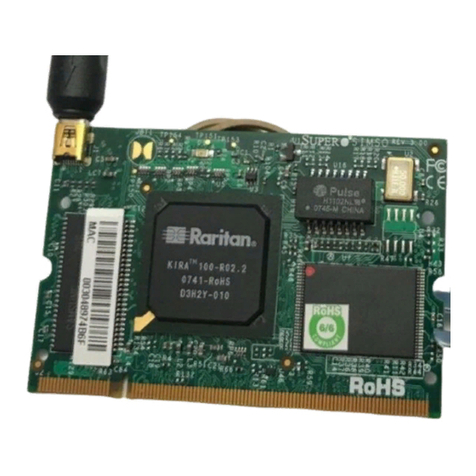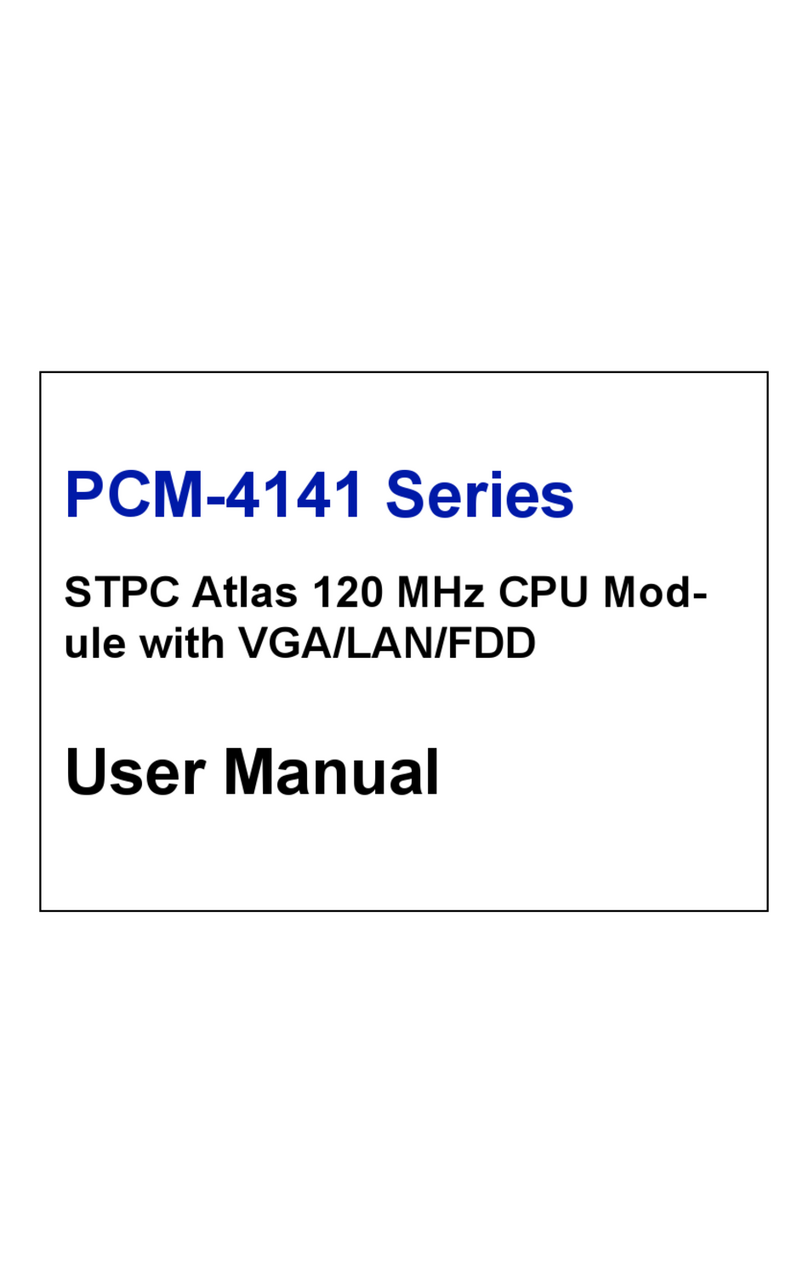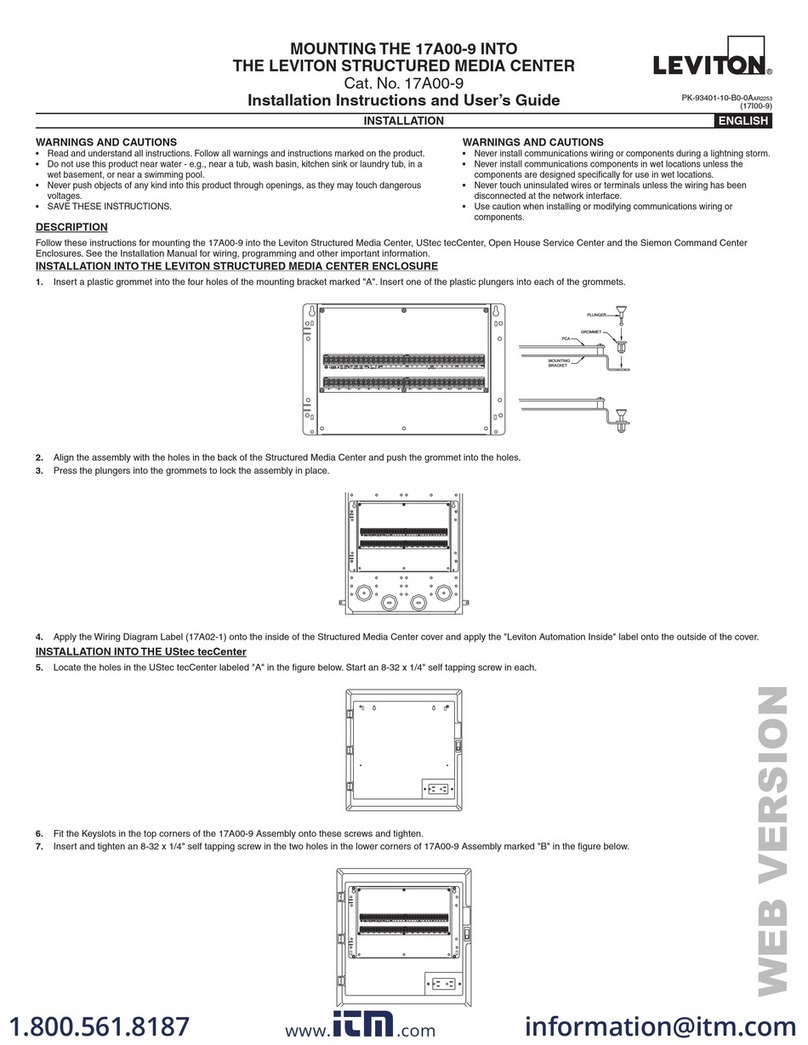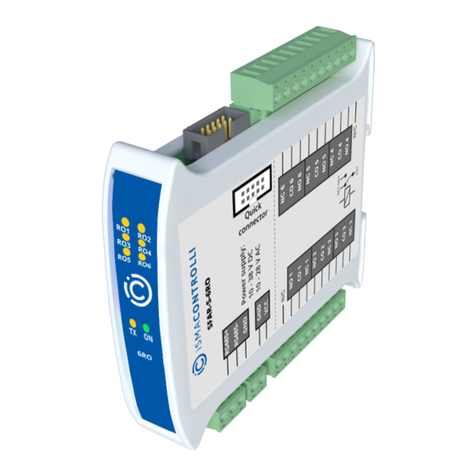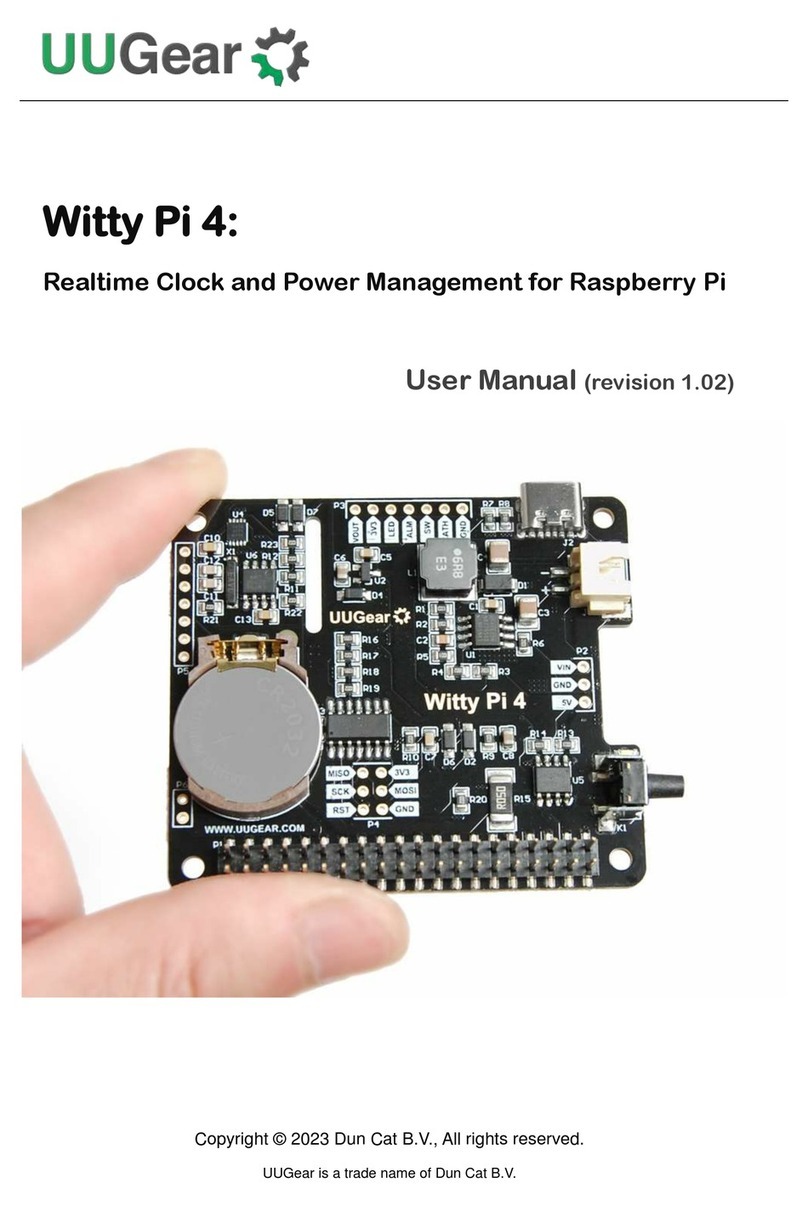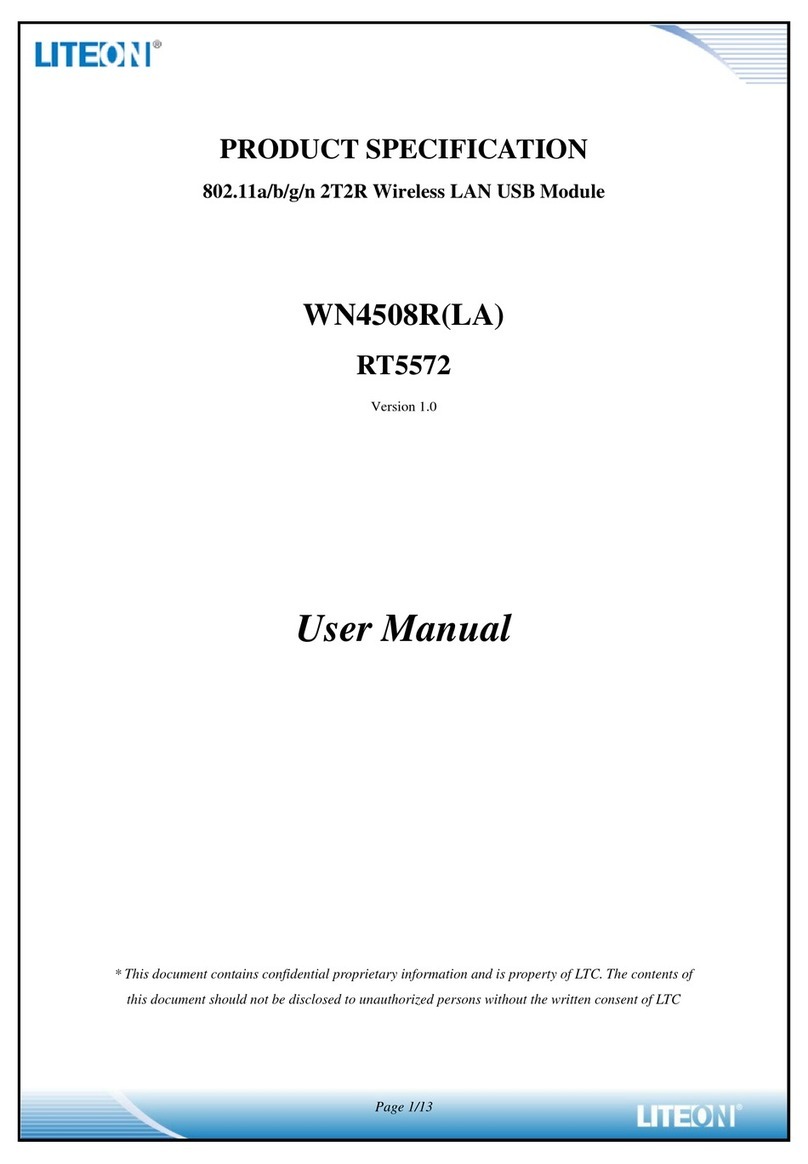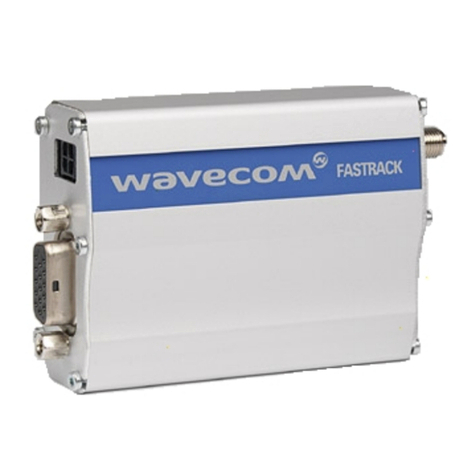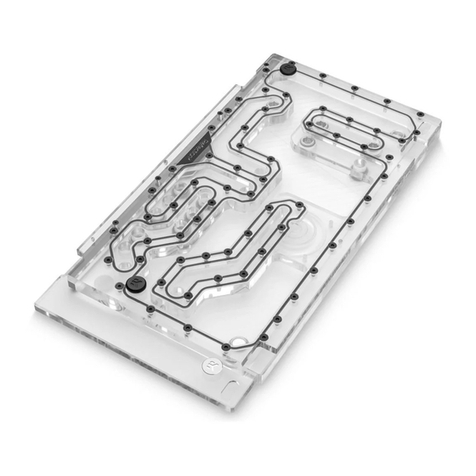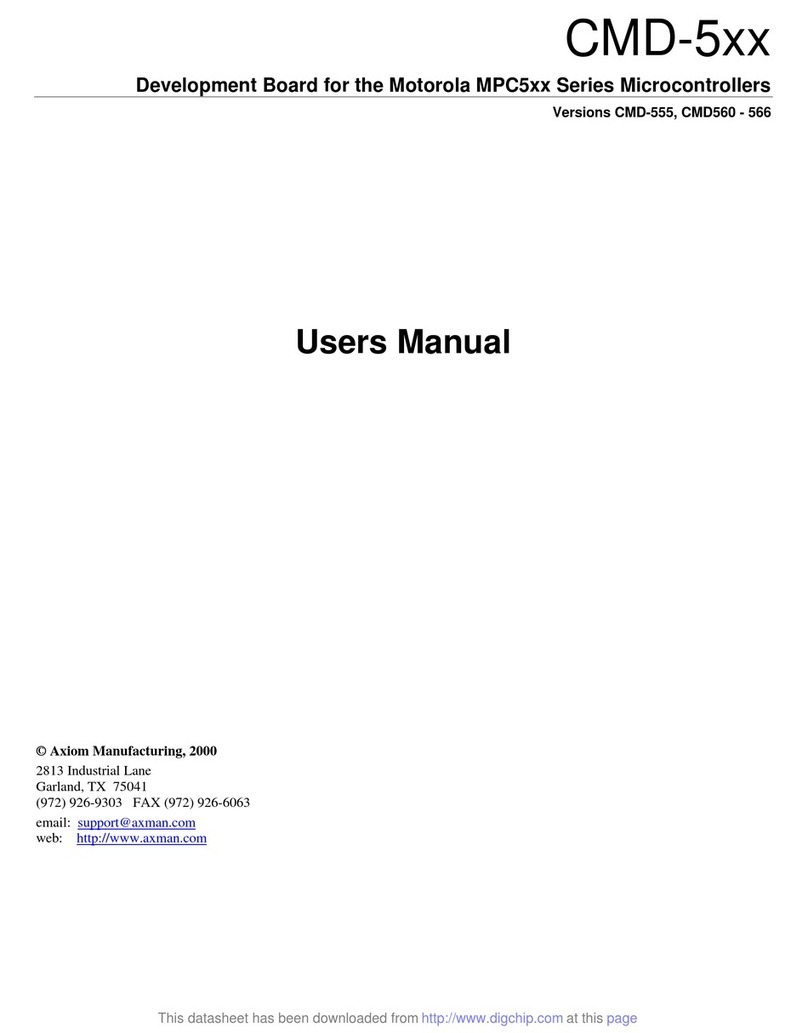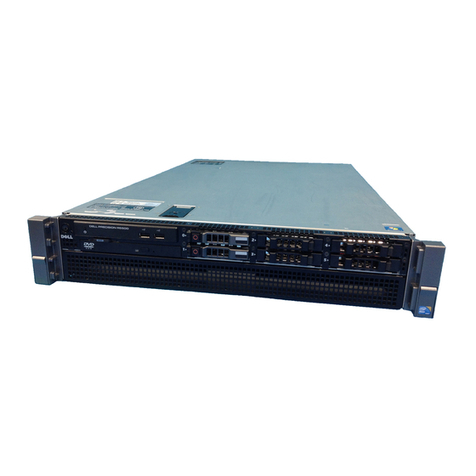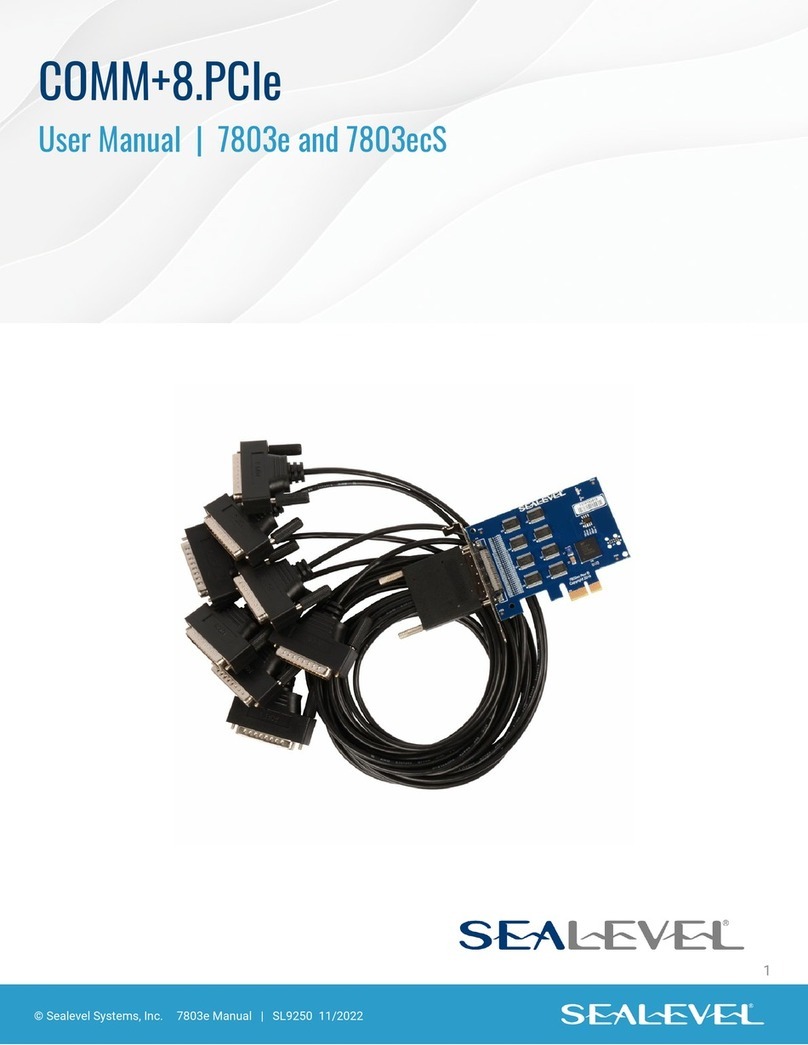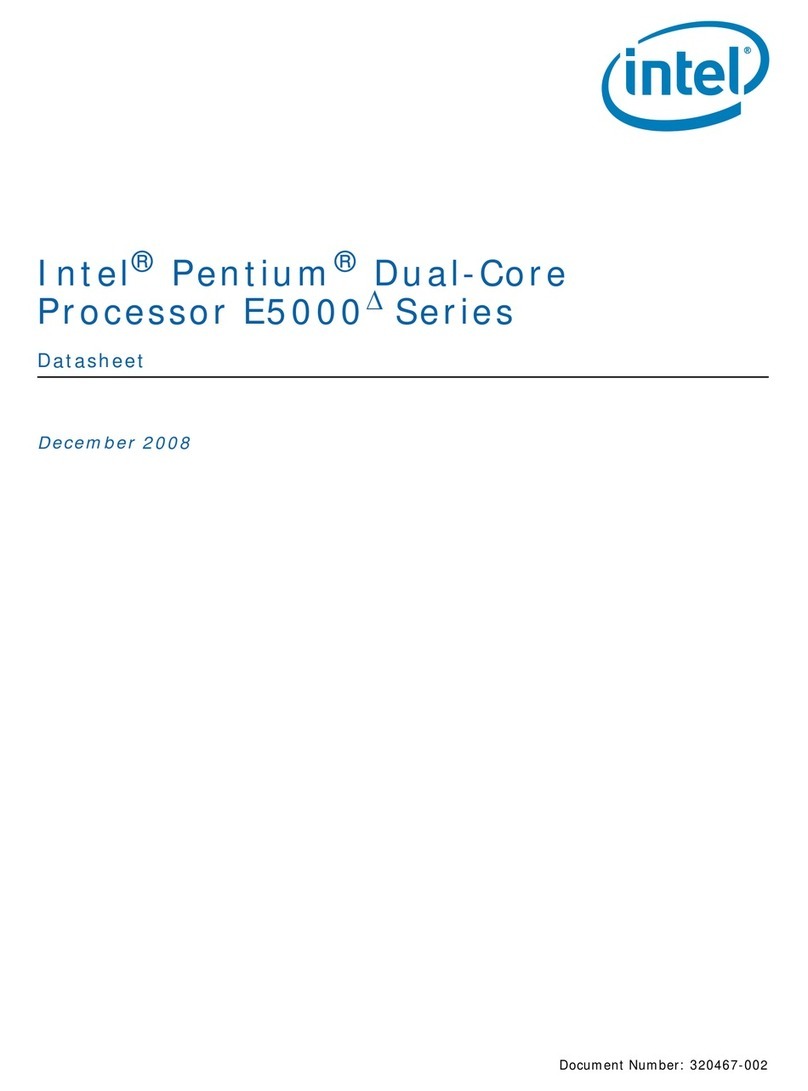Seattle Computer Products 8086 CPU User manual

Instruction Manual
Model
SCP
2008
BOB6CPU
16-BitProcessorforthe
5-100
Bus
Rev.S
10-1-80
.
Asaattla
(omputar
Products,Inc.
~
1114 Industry Drive. Seattle.
WA.
98188
(206) 575-1830

..
TABLE
OF
CONTENTS
Features
Configuration
Options.
Technical
Description.
1.
0
General
2.0
Features
and
Comparisons
to
IEEE
Standard.
3.0
S-100
Connector
Layout.
4.0
A.C.
Characteristics.
Theory
of
Operation.
One-Year
Limited
Warranty.
- 2 -
3
3
5
5
5
9
.10
.14
.21

Features
>Advanced
16-bit
architecture
of
the
8086 includes aversatile range
of
addressing modes,
hardware
multiply and
divide,
and high-speed
string
operations.
>Fully meets IEEE-696 standard
for
16-bit
operation
on
the
5-100
bus,
allowing
maximum
throughput.
>
Completely
compatible
with
8-bit
memory
and
I/O
devices
with
reduced
performance.
>
Directly
addresses up
to
1megabyte
of
memory,
eliminating
the need
for
"bank select".
>Has aminimum
instruction
execution
time
of
only
250 nanoseconds,
yet
needs
no
"wait
states"
with
static
memory
of
250 nsec.
or
faster.
>Entire design
conforms
to
IEEE-696 standard
for
the
5-100
bus.
>Configurable
to
meet awide range
of
system requirements
through
its numerous switches and
jumpers.
Configuration Options
SWITCH
SELECTED
OPTIONS
5-1,
located
near the
top
of
the
board
between U4 and U5 has
three
active
segments. The
segments
of
the
switch
and
their
function
are:
Segment 1:
Not
used
on
this
board.
Segment 2: Sixteen aCknowledge
--
the closed
position
allows the
CPU
to
look
at
the
sXTN*
line
to
determine
if
the
peripheral
being accessed can
do
asixteen
bit
transfer.
The open
position
forces
the
CPU
to
do
all
eight
bit
transfers. The
switch
is
provided
because
some
of
the
early
eight-bit
systems used this line (60)
for
another
purpose.
The
switch
allows the user
another
capability
as
well.
It allows
him
to
compare
program
execution
time
differences
while
using
eight-bit
or
sixteen-bit
memories.
Segment
3:
This
switch
selects between
4M
Hz
and
8M
Hz
operation
with
8MHz
CPU
cards.
The
closed
position
selects 4MHz, open selects 8MHz. On 4MHz CPU cards this
switch
segment is
defeated by ajumper and
has
no
effect;
the
CPU
always runs
at
4MHz.
Segment 4: Closing this
switch
adds
one
wait
state
to
each
bus
cycle.
If a
peripheral
has
it's
own
wait
state
generator,
closing
segment 4adds one
wait
state
in
addition
to
the one(s) requested
by
the
peripheral.
With
the
4MHz
clock,
memory
chip speed requirements
are
in excess
of
450n5.
At
8MHz, 250nS
or
faster chips must be used. Thus,
with
most
memory,
and a4MHz
clock,
no
wait
states are required and the
switch
segment should remain in the "open"
or
off
position.
- 3 -

JUMPERS
There are six jumpers on the
board
to
allow
configuring
your
CPU
for
special
situations.
The
chart
below
shows
their
"normar
positions.
NAME
NO~MAL
POSITION
~EMA~KS
STV (Status
Valid)
"0" Used
with
OMA
STK
"E"
Used
with
DMA
1-0
"8" Puts
lower
8-bit
1-0
address on
upper
8-bits
PHANTOM*
"+"
Connects
PHANTOM* line
SXI<Q
(sXTRQ*)
"+"
Connects Sixteen Request line
MWRITE
"+"
Connects
MWRITE
line
Each
of
these jumpers
will
be discussed in
more
detail
to
enable
you
to
determine
if
you
should change them
to
the alternate
position.
STV (Status
Valid)
--
this jumper
controls
the
function
of
the pSTVAL* line (S-100
pin
25)
during
OMA:
In
the
"E"
position
the CPU always drives the pSTVAL*line.
In
the
"Ui
position
this line
is
three-stated
when
COSH*
(control
disable, S-100
pin
19)
is
low
allowing
the OMA
device
to
drive
it.
'-
STK
--
this jumper
controls
the
function
of
the
"SPEED"
line (S-100 pin
98)
during OMA.
In
the
"E"
position
the CPU always drives this line
with
ahigh
to
indicate
8MHz
operation
or
low
to
indicate
4M
Hz
operation.
In
the
"D"
position,
this line
is
three-stated
when
SDSl:3·
(status disable,
5-100
pin
18)
is
low
allowing
the
UMA
device
to
drive
it.
1-0
--
In
the
normal
"8"
position,
this jumper copies the
lower
8bits
of
I-Q
address
information
onto
the
next
higher
8address bits. If
your
1-0
devices
use
a
16-bit
address, the
jumper should
be
in the
16-bit
position.
Most
existing
I-Q
devices use addressing in
which
the
lower
and middle address bytes are the same.
The
upper address byte,
A16-A23,
is
never used in
I/O
addressing.
PHANTOM*
--
This
CPU
board
generates aPHANTOM* signal whenever
it
addresses
memory
locations
located
above
the
lowest
64K. This signal may be used
to
disable
older,
8-bit
memory
cards
which
do
not
have extended addressing. Through the
use
of
this PHANTOM· signal, asystem
may be
composed
of
up
to
64K
of
the
older,
non-extended
addressable
memory
which
would
be
located
in the
lowest
64K and
newer,
extended addressable
memory,
located
in the higher
addresses. The PHANTOM* signal
would
prevent
the
older
memory
from
interfering
with
the
memory
located
at
the higher addresses. If
your
system
uses
this signal
for
some
other
purpose,
the
PHANTOM* generated
on
the CPU
board
should be disconnected
from
the
bus
by
putting
the
PHANTOM* jumper in the "_"
position.
sXT~Q*
--
The Sixteen Request signal
is
generated by the
CPU
whenever
it
wants
to
do
a
16-bit
transfer.
In
our
system, using
16-bit
memory,
this jumper should be
connected
in the
"+"
postion.
If
you
do
not
have
16-bit
memory
in
your
system, the signal
would
serve
no
purpose and
the jumper
could
be
in
either
position.
If
your
system
uses
bus
line 58
for
some
other
purpose, the
sXT~Q*
line should be
disconnected
between the
CPU
and the
bus
by placing the jumper in the "_"
position.
- 4 -

•
MWRITE
--
This jumper connects the
MWRITE
line
of
the
CPU
board
to
the bus. It
is
normally
connected
and used by
most
systems
as
the
primary
write
line. It should be disconnected
if
MWRITE
is
generated somewhere else in the system, such
as
on a
control
panel
or
the
motherboard.
Disconnect by placing the jumper in the
"_"
position.
Technical
DescrlpUon
1.0 General
The SCP-2oo
CPU
card
is
an
Intel 8086
CPU
chip
with
the
electrical
and mechanical hardware
to
interface
it
to
the 5-100
bus
in
accordance
with
the
proposed
IEEE
standard. It may be used
to
upgrade the
performance
of
present S-1oo systems by swapping
CPU
cards
or
it
may
form
the
foundation
of
ahigh
performance
16-bit
computer.
Some
prior
knowledge
of
the fundamentals
of
the S-1oo
bus
is essential
to
understanding this
document.
A
thorough
understanding requires
familiarity
with
the
IEEE-696 standard
for
the S-100
bus. The asterisk
(*)
denotes
an
active-low
signal.
2.0
Features and Comparisons
to
Proposed Standard
2.1
Clock
All
timing
signals are
derived
from
an
on-board
24 MHz
oscillator.
The
clock
rate
of
the
8086 chip itself
is
either
4
or
8MHz. A
lower-priced
version
of
the
board
is
capable
of
4MHz
operation
only,
while
the
higher-priced
version
has
switch
selection
of
either
a 4
or
8MHz
clock.
All 4
MHz-only
CPU cards are
factory
upgradable
to
4/8
MHz.
On the bus, CLOCK (pin 49) is always 2MHz,
while
pSTVAL*
(formerly
m1,
pin
25)
and
~
(formerly
~2,
pin 24) are equal
to
the
clock
frequency
of
the
CPU
(4
or
8MHz). All three are
approximately
square waves. pSTVAL*and
!>
are equal in phase,
but
pSTVAL*may be
configured
to
be disabled
(tristate)
by CDSB* (pin
19)
while
~
is
never disabled.
The 8086 allows 3
clock
cycles
for
memory
access (minus delays and setup
time).
At
8MHz,
250
ns
memory
is
required
while
at
4MHz,
over
500
ns
access
time
is
allowed.
(see
section
4.)
If
more
time
is required, the
card
may
be
switched
to
insert
a
wait
state in
every
bus
cycle•
.,
addition, the line
formerly
named sSTACK (pin 98)
is
driven
with
clock
speed
status--high
for
8
MHz,
low
for
4
MHz.
This may be used
to
control
wait
state
generators
of
peripherals.
2.2 Data
Bus
The 8086
CPU
chip
is a
16-bit
processor
which
is
interfaced
to
the S-100 bus by the
support
logic in
either
of
two
modes:
8-bit
mode
or
16-bit
mode.
The
mode
is
selected dynamically
at
the
beginning
of
each
bus
cycle, depending on
CPU
status and
bus
response,
as
follows:
2.2.1 sXTKQ*, SIXTN*
If
the
processor
wishes
to
read
or
write
16 bits, sXTRO* (pin 58) on the
bus
is
driven
low.
The
addressed device may then respond by pulling
low
SIXTN* (pin 60)
if
it
can
perform
a
16-bit
parallel
transfer.
Timing
for
SIXTN* is the same
as
the READY lines
(RDY/XRDY)--it
must be valid 50
ns
before
the rising edge
of
~
that
ends pSYNC. An
exception
to
this
is
that
if
a
wait
state
is
requested (externally
or
on-board),
SlXTN* may be delayed until
near
the end
of
the last
wait
state.
SIXTN*
is
latched on the rising edge
of
~,
either
near the end
of
pSYNC
or
near the end
of
the last
wait
state, and changes
after
this
time
are
irrelevant.
If, at the
time
SIXTN*
is
latched,
it
is
high
(inactive),
then sXTRO*
is
removed
and
double
8-bit
mode
is selected.
Utherwise,
sXTRO* is kept
low
and
16-bit
mode is selected.
Should
the
8086 CPU .card be used in asystem
which
previously
defined a
conflicting
use
for
bus
pins
58
or
60,
either
or
both
of
these lines may
be
disconnected
from
CPU
logic.
In
this case,
16-bit
mode
is
not
possible.
- 5 -

2.2.2
8-Bit
Mode
2.2.2.1
Simple
8-Bit
Mode. This
mode
is
used when the
processor
wishes
to
transfer
only
1
byte.
Logic
on
the
card
routes
data
1)
from
the
01
bus
to
the processor's
low
8data lines (read even
location);
2)
from
the
01
bus
to
the processor's high 8
data
lines (read
odd
location);
3)
from
the
processor's
low
8data lines
to
the
DO
bus
(write
even
location);
4)
from
the processor's high 8
data lines
to
the
00
bus
(write
odd
location).
2.2.2.2
Double 8-l:Jit Mode. This
mode
is used when the
processor
wishes
to
transfer
a
word
on
an
even address but the
memory
or
I/O
device
is
not
capable
of
16-bit
operation.
The
processor
is
put
into
a
wait
state
for
at
least 4
clock
periods
while
on-board
logic
runs
two
bus
cycles
back
-to-back,
first
at
the even address, then
at
the
odd.
Each
bus
cycle
is
essentially the same
as
in
simple
8-bit
mode
above,
except
the data resulting
from
the
first
of
two
read cycles is latched until
the second
cycle
is
complete.
2.2.3
16-l:Jit Mode
In
this mode, 16 bits
of
data are
transferred
in parallel in one
bus
cycle.
The DO lines
carry
data
to/from
the even addressed
location
(processor's
low
8data lines), and
the
01
lines
carry
data
to/from
the odd addressed
location
(processor's high 8
data
lines).
2.2.4 Data
Driver
Disable
I:Jringing
low
OOOSB* (pin
23)
will
disable
both
the data
input
and data
output
drivers.
2.2.5 Co
mpatibility
The techniques
for
mode
selection and
16-bit
transfer
are in
strict
accordance
with
the
proposed
IEEE
standard. They allow the CPU
to
run
without
modification
with
ordinary
8-bit
memory
(for
easy upgrade),
with
new
16-bit
memory
(for
high
performance),
or
even
in
amixed
environment
(e.g.,
16-bit
memories
in
time-critical
code
areas).
2.2.6
Oata Line
Connector
Connector
]1, a
16-pin
IC
socket,
is
provided
to
allow
monitoring
the data lines
of
the 8086
CPU
chip.
Pins
1
to
16
of
this
socket
are
connected
to
ADO
to
AD15
of
the
8086, respectively.
Further,
by using
DOD5~*
to
disable the data
drivers
when the
board
is
reading (pOBIN
active),
arbitrary
instructions
or
data may be fed
to
8086
through
this
connector.
2.3
Address
!:Jus
2.3.1
Memory
Address
The
proposed
IEEE
standard dedicates 24 pins on the
bus
for
memory
address
information.
All 24 are
driven
by the CPU
card;
however
since
the
8086 chip
itself
generates
only
20
bits
of
address,
A20-A23
are always
driven
low.
2.3.1.1 Phantom
Traditionally,
5-100
memory
cards have decoded
only
the
lowest
16 address lines,
limiting
their
address space
to
64K bytes.
Ordinarily,
use
of
such cards in asystem
with
more
than
64K
is
not
possible because these cards
will
appear in the same
relative
position
in each 64K
block.
However,
special
provision
has
been made on
the
8086 CPU card, selected by ajumper: Whenever a
memory
location
ABOVE
the
lowest
64K is addressed, PHANTOM* (pin 67)
is
driven
low,
which
may
be
used
to
disable
memories
with
a
16-bit
address.
Thus
these memories appear only in the
lowest
64K, when PHANTOM* is
not
being
driven.
The
PHANTOM*-driving
circutiry
on the
CPU
card
continues
to
function
during DMA. Thus
OMA
controllers
which
use
a
24-bit
address need
not
be
concerned
with
the presence
of
memories
using
only
a
16-bit
address. - 6 -

2.3.2
"put/Output
Address
The
proposed
standard allows and the 8086
CPU
chip
supports a
16-bit
I/O
address.
However,
traditionally
the
lower
8bits and
upper
8bits
of
the address have been the same, and
/".
unfortunately
many devices have been designed
which
decode
their
I/O
address
from
the upper 8
lines. To maintain
compatibility
with
such devices the
support
logic
can be jumpered
to
throw
away
the
high 8bits
of
the 8086's
I/O
address and substitute
the
low
8
bits.
2.3.3 Address
Driver
Disable
Bringing
low
ADSB* (pin
22)
will
disable the address
drivers.
2.4 Status
Bus
The
CPU
card
drives all status lines in
accordance
with
the
proposed
standard. They are:
NAME
PIN
sMEMR
47
sM1
44
slNP 46
sOUT 45
sWO* 97
slNTA 96
sHLTA
48
sXTRQ* 58
2.4.1 Status
Driver
Disable
Hringing
low
SDSH*
(pin 18)
will
disable the status
drivers.
Clock
speed status, pin 98, may
optionally
be
disabled by this signal
if
necessary,
to
be consistent
with
its
traditional
definition
as
the
sST
ACK status line.
2.5
Control
Bus
All
control
lines are in
accordance
with
the
proposed
standard. They are:
OUTPUTS
PIN
INPUTS
PIN
pSYNC
76
ROY
72
pSTVAL- 25
XROY
3
pDBIN
78
IN
I-
73
pWI<-
77 NMI-
12
pH
lOA
26
HalO-
74
SIXTN- 60
Traditionally,
another
control
line
has
been
pWAIT
(pin
27).
This line is
driven
by the
CPU
card
and
goes high
as
pSYNC goes
low
if
the
bus
is
put
into
a
wait
state.
2.5.1
Control
Driver
Disable
r-
Bringing
low
CUSH- (pin 19)
will
disable the
control
drivers.
Traditionally,
pin 25,
now
pSTVAL
-,
has
not
been disabled by this signal. Ajumper
is
provided
to
select whether
or
not
it
will
be disabled.
- 7 -

2.6
Power
Supply
Only
+8V (pins 1&
51)
and GROUND (pins 50 &
100)
are used
for
power.
Two
on-card
regulators
provide
+5
Vat
1.2 A
(typical)
to
all
circuitry.
2.7
Other
lines
2.7.1 Reset
POC* (pin 99)
is
a
totem-pole
output
driven
low
momentarily
when
power
is
first
applied
to
the
card.
During this
time
RESET*
(pin 75),
normally
an
input,
is
also
driven
low.
The
CPU may be
reset
at
any
time
by
driving
RESET·
low
for
5
or
more
p
cycles.
After
reset,
the
8086
will
begin
program
execution
at
OFFFFOH.
See
Intel's 8086 Family User's
Manual
fo
rdetails.
2.7.2
MWKITE
The
CPU
card
normally
generates
MWKITE
(pin
68).
If
this
signal is generated elsewhere
in
the
system, this
function
may
be
defeated by
removing
ajumper.
2.8
Front
Panel
Co
mpatibility
There
is
currently
no
hardware
front
panel
for
the 8086
on
the S-100 bus. With one simple
modification,
an
IMSAI
front
panel may be used
to
run, stop, single step, and observe address and
data.
Note
that
EXAMINE
and
DEPOSIT
functions
will
not
work.
A
16-pin
socket
directly
connected
to
the
8086's Address/Data lines
is
provided,
with
pins
1-16
wired
to
ADO-AD15, respectively. This
may be used
with
an
IMSAI
front
lJanel
to
observe 8data bits
at
a
time.
Only pins 9
through
16
of
the
IMSAI
front
panel
connector
are used. To observe the
low
(even) data byte, plug pins 16
to
9
into
pins 1
to
8
of
the
socket
(the cable should extend
downward).
For
the high
(odd)
data byte,
pins 9
to
16
of
the cable plug
into
pins 16
to
9
of
the
socket
(the cable should extend
upward).
When
the
processor
does a·double
gulp·--two
8-bit
reads when 16 bits are
needed--both
halves
of
the
word
will
be displayed sequentially on the high data lines.
The
modification
to
the
IMSAI
front
panel
to
allow
single stepping
is
made on the
front
of
the
circuit
board,
near the edge
connector
below
address
switch
6.
Cut
the trace
to
connector
pi n39
(this
trace
comes
in
at
45
degrees). Install ajumper
from
this
trace
to
the
trace
connected
to
pin
44 (the
next
trace
to
the
right).
It
will
be necessary
to
scrape away a
portion
of
the solder mask
from
both
traces.
This change
will
not
affect
operation
of
the
front
panel
with
8080 CPUs.
- 8 -

3.0
S-100
Connector
Layout
PIN
NAME
PIN
NAHE
/...•
1
+8
Volts
51
+8
Volts
2+16
Volts
52
-16
Volts
3
XRDY
53
4
54
555
6
56
757
858
sXIRQ*
959
A19
10
60
SIXIN*
11
61
A20
12
NMI*
62
A21
13
63
A22
14
64
A23
15
A18
65
16
A16
66
17
A17
67
PHANTOM*
18
SDSB*
68
MWRITE
19
CDSB*
69
20
70
21
71
22
ADSB*
72
RDY
23
DODSB*
73
INT*
24
~
74
HOLD
*
25
pSTVAL*
75
RESET*
26
pHLDA
76
pSYNC
27
pWAIT
77
pWR*
28
78
pDBIN
29
AS
79
AO
30
A4
80
Al
31
A3
81
A2
32
A15
82
A6
33
A12
83
A7
34
A9
84
A8
35
DOl
85
Al3
36
DOO
86
A14
37
AIO
87
All
38
D04
88
D02
39
D05
89
D03
40
D06
90
D07
41
DI2
91
DI4
42
DI3
92
DI5
43
DI7
93
DI6
44 sMl
94
DI1
45
sOUT
95
DIO
46
sINP
96
sINTA
47
sMEHR
97
sWO*
48
sHLTA
98
SPEED
49
CLOCK
99
POC*
50
GROUND
100
GROUND
- 9 -

4.0
A.C.
Characteristics
The
symbol
in
the
left
column
is
of
the
form
TAYBZ
where
Tmeans a
timing
measurement;
A,B
are
abbreviations
of
signal
Y,Z
are
abbreviations
of
signal
It
means
the
time
from
the
first
signal
second
signal
reaches
the
second
level.
The
following
abbreviations
are
Signal
Names
A -
Address
bus
C -
Clock
(~)
D -
pDBIN
I -
Data-in
H -
HWRITE
o -
Data-out
R -
Ready
(RDY
/XRDY
/SIXfN*)
S -
Status
bus
V -
pSTVAL*
W -
pWR*
Y - pSync
names;
levels.
reaching
the
first
level
until
the
used:
Signal
Levels
H -
High
L -
Low
V -
Valid
X -
Invalid
For
example,
TRVCH
means "Time
from
Ready becomes
Valid
until
Clock
goes
High."
Times
specified
are
in
nanoseconds,
either
minimum
or
maximum
as
appropriate
for
a
worst-case
specification.
Times
listed
are
for
a 4
MHz
clock,
for
an 8
MHz
clock,
and
for
comparison
purposes,
the
requirements
of
the
proposed
S-100
standard
at
411Hz. The maximum
clock
speed
covered
by
the
standard
is
6
MHz.
-10 -

Symbol
Description
4
MHz
8
MHz
S-100
(4
MHz)
INPUTS
TAVIV
Allowed
address
access
time
575 260
TVLIV
Access
time
from
pSTVAL*
310 130
TRVCH
RDY
/XRDY
/SIXI'N*
setup
time
50 50
80
TCHRX
RDY
/XRDY/SIXI'N*
hold
time
00
70
TDLIX
Data-in
hold
time
0 0
50
TDHIV
Driver
enable
time
for
slaves
170
50
50
OUTPUTS
TCLCL,TCHCH
Clock
period
250 125 250
TCHCL,TCLCH
Clock
pulse
width
120 58 113
TCHYH,TCHYL
Clock
to
pSYNC
delay
20
20 100
TYHYL
pSYNC
pulse
width
240 115 175
TVLYL
pSTVAL*
low
before
pSYNC
low 125
62
0
TVHVL
pSTVAL*
pulse
width
high
120 58 50
TVLVH
pSTVAL*
pulse
width
low 120 58 50
TVLYH
pSTVAL*
low
before
pSYNC
high
125
62
0
TYHVL
pSYNC
high
before
pSTVAL*
low 100
45
50
TAVYH
Address
valid
before
pSYNC
140
60
TSVYH
Status
valid
before
pSYNC
160
35
except
sXI'RQ*
70
0
/~
......
TSVVL
Status
valid
before
pSTVAL*
low 180
50
40
TDLAX,TDLSX
Address/status
hold
after
pDBIN
160
80
50
TDHDL
pDBIN
pulse
width
240 115 225
TWLWH
pWR*
pulse
width
240 115 225
TVLWL
pSTVAL*
low
before
pWR*
low 125
62
30
TOVWL
Data-out
setup
time
before
pWR*
170
45
25
TWHOX,
TWHAX,
TWHSX
Data-out/address/status
hold
160
80
50
TWLMH,
TIIHML
ffiY:RITE
delay
from
pWR*
30 30 30
-
11
-

STANDARD BUS
CYCLE
c-
f--
TCHCL-
f--TCLCH-
~
j
1\
TYHYL
TCHYH TCHYL
J
1\
TYHVL
I-TVLYH
TVLYL-
r--
TVHVL-
r-TVLVH-!
1\
I
I-----TAVYH-
111
\/\
I
I--TSVYH-
~TDLAX-
TSVVL
X
TDHDL
TDLSX-
\
-+--TDHIV-
X
~~
TAVIV
j----.
~TDLlX
1\
f---TOVWL
TWLWH
TWHOX
____
,
II
I----TVLWL-
1\
J
TWLMH-
-TWHML
--f
pWR*
MWRITE
DATA
IN
STATUS
pDBIN
DATA
OUT
ADDRESS
pSTVAL*
pSYNC
-12 -

pSYNC
RDY,XRDY
SIXTN*
BUS CYCLE WITH ONE
WAIT
STATE
pWAIT I\
I\
pDBIN
I
pWR* \
-13 -

Theory
of
Operation
Most
of
the signals described
below
are shown in the
timing
diagram
accompanying
this Theory
of
Operation.
The
diagram
shows a
typical
double
a-bit
transfer
or
"double
gulp:
The names
of
various
signals
followed
by
an
asterisk signify an
active
low
signal and
correspond
to
"barred"
names
on
the
schematic.
For
example, ALE*
is
the same
as
AlE.
Clock
Circuitry
The main
timing
source
for
the 8086
CPU
Card (and thus the
entire
system) is a24 MHz crystal
clock.
The 24 MHz
clock
is
divided
by
two
by half
of
U9.
The
other
half
of
U9 synchronizes the
output
of
the SP4/8
switch.
3/4
of
U10 is used
as
a
multiplexer
to
select
either
24 MHz
or
12
MHz.
The 24 MHz
clock
is
also
divided
by 12 by U26
to
provide
the
2MHz "CLOCK" line,
5-100
pin
49.
The
12
or
24 MHz
output
from
U10 (pin 13) drives a
three
bit
ring
counter
which
divides the
12
or
24 MHz signal
by
three
to
provide
three
one-third/two-thirds
duty-cycle
4
or
aMHz,c1ocks
~A,
~U,
and
~c.
<PC
is shifted
one-half
clock
by half
of
U3, the result on pin 2is buffered by one
section
of
U25 and fed
to
the
8086
as
its
clock.
ipc
and
the
8086
clock
are
combined
by aNOR
gate
to
form
~2,
which
in turn
is
driven
onto
the
bus
as
~
(pin
24)
and pSTVAL*(pin
25).
The
timing
relationships between these
various
clocks are shown in the
accompanying
diagram.
~us
Cycle
Control
Circuitry
The
8086
itself
is
operated
in the "MAX"
mode
therefore
the
start
of
a
bus
cycle
is
indicated
by one
or
more
of
the
three
status lines
SO*,
51*,
or
52*
going
low.
The
circuit
made up
of
a
NAND
gate
from
U4,
an
AND
gate
from
U5, and a
J-I<
flip
flop
from
U14
provides
the
LOAD
signal
at
pin 6
of
U5.
As
shown in the diagram,
LOAD
goes high when status goes
active
and
is
clocked
low
on the
next
falling edge
of
~2.
LOAD is used
primarily
to
load data
into
U6, the
bus
cycle
control
shift
register.
LOAD
is
also used
to
latch the
three
8086 status lines and
to
set
ALE
high.
ALE
(Address
Latch Enable) is generated by half
of
U22, a D
flip
flop.
LOAD is used
to
set
ALE
high,
ALE
clocks
low
on
the
next
falling edge
of
~,
the
8086
clock
which
is
roughly the same
as
the rising edge
of
m2.
ALE
is used
to
latch the address
output
from
the 8086
AD
pins. Since the AD pins are
multiplexed address/data pins the address
is
soon
replaced by data and must be latched in
order
to
last
through
the
bus
cycle.
U6
is a
four
bit
shift
register
which
is used
to
time
the
four-clock
bus
cycles.
As
aresult
of
the
LOAD
signal
going
hi~h,
U6
is
loaded
so
that
T1
is
high and
TO,
12,
and
13
are
low.
At
the falling
edge
of
~2,
the "one" loaded
into
T1
is
shifted
to
the
next
output.
T1
is delayed
one-half
clock
by
one
section
of
U20
to
form
pSYN
C
(5-100
pin
76).
12
is
gated
with
various
status
information
and
then delayed
one-half
clock
by
other
sections
of
U20
to
provide
pDHIN (5-100
pin
78) and
pWR*
(5-100
pin
77).
The
diagram
shows the
timing
relationships between
TO,
T1,
12,
13,
pSYNC, pDHIN,
and pWR*.
sXTkQ*/SIXTN*
Circuitry
When
ALE
goes
high
it
sets
pin
6
of
U22 (a 0
flip
flop)
low.
Pin
6
of
U22 is the
WAIT
signal shown in
the diagram, its
function
is
to
put
the CPU
into
a
wait
state
if
the CPU
is
attempting
to
perform
a
sixteen
bit
transfer
but the
device
to
be transfered
to
or
from
can't
do
sixteen
bit
transfers. If such
a
situation
occurs
the
output
of
the NANDgate U32,
pin
6
will
be
low
because
SXT
will
be
high
indicating
that
the
CPU
wishes
to
do
asixteen
bit
transfer
and SIXTN*
will
be high
indicating
that
the
device
to
be transfered
to
or
from
can't
do
it.
Since the
output
ot
the
NANO
gate is
low,
WAIT
will
clock
high on the
next
rising edge
of
ill2
after
ALE
goes
away.
WAIT
connects
to
pin 3
of
U27,
an
input
to
aNOR gate.
The
output
will
thus go
low
which
drives the READY input
to
the
8086
low
putting
it
in a
wait
state
(four
to
be
exact).
WAIT
is
connected
to
the J-K inputs
of
both
sections
of
-
14
-

U23, adual J-K flip
flop.
Both sections are
clocked
on the falling edge
of
T2. If
WAIT
is
high, then
DONE(pin 3
of
U23)
will
remain
low
indicating
that
we
are
not
done
yet.
U23
pin
5(called U23-5
in the
diagram)
will
go high which removes the sXTRQ* signal
from
the
bus
since
we're
not
doing
a
sixteen-bit
transfer.
Meanwhile, the
bus
cycle
control
shift
register clocks
T3
high.
T3
connects
to
both
the Jand K
inputs (pins 1and 4)
of
U14, aJ-K flip
flop.
When
~2
falls
with
T3 high the
output
at
pin
3
of
U14
toggles
which
sets ODDBT high indicating
that
we've
done the even byte and
now
we're
going on
to
do
the odd byte.
Notice
that
ODDBT and
T2
go
into
pins 9and
10
of
U21
(a
NAND
gate)
to
provide
asignal called ROY* but since
T2
has
already gone
low,
RDY* stays high when ODDBT goes
high. T3
is
connected
to
the
SERIAL
IN
pin
of
the
bus
cycle
control
shift
register
so
that
when
T3
clocks
low,
TO
clocks high.
TO
and DONE
go
into
pins 4and 5
of
U21
(a
NAND
gate)
the
output
of
which
is
connected to the
CLEAR
pin
of
the
shift
register. But since DONE
is
still
low
as
mentioned
above,
the
shift
register isn't cleared.
As
the
shift
register clocks
two
more
times and
first
T1
then
T2
go high
as
asecond
bus
cycle
is
performed,
this
time
with
ODDBT high.
When
T2
goes high the second time, ODDBT
is
high also and RDY* (pin 6
of
U21) goes
low.
RDY*
is
connected
to
one
of
the inputs (pin 5
of
U32)
of
the
four-input
NAND
gate which
has
SXT
and
SIXTN* connected
to
it.
The
output
of
the
NAND
gate (pin 6
of
U32)
now
goes high since one
of
the inputs
went
low.
Therefore, on the
next
rising edge
of
~2,
WAIT goes
low.
On
the falling edge
of
T2, DONE goes high since
WAIT
has gone
low.
When
T2
went
low,
T3
went
high raising the Jand
Kinputs (pins 1and 4
of
U14) putting the ODDBT flip flop in the toggle mode.
On
the
next
falling
edge
of
~2
ODDBT goes
low
again indicating that the odd byte
has
been transfered.
When
T3
falls,
TO
goes high once
more
and this
time
DONE
is
high
so
the clear input
to
the
bus
cycle
control
shift
register (pin 1
of
U6) goes high. Since the clear input
is
asynchronous the clear pulse
is
self-annihilating:
as
soon
as
clear goes
low,
so
does
TO.
When
TO
goes
low,
so
does clear.
If
SIXTN* is
low
(indicating
that
the device can do asixteen
bit
transfer), things are a
lot
simpler.
The
0input
to
the flip
flop
which generates
WAIT
(pin 2
of
U22)
will
be
high due
to
SIXTN*
being
low.
Therefore
WAIT
will
never
go
high,
DONE
will
come
on when
T2
falls and U23 -5 (pin 5
of
U23)
will stay
low
keeping sXTRQ*
active
during the whole
cycle.
ODDBT
will
still
go
high
at
the end
of
T3
but
will
be cleared
next
time
ALE
happens.
If
the 6086
wasn't
doing
asixteen
bit
transfer
SXT
would
be
low
and this would" have the same
effect
as
SIXTN*
being
low:
no
second
bus
cycle.
The Data Buffer Enable
(GA*
-
GE*)
Circuitry
and Data Buffers
This
circuit
takes
as
its inputs OODBT,
LAO
(Latched
AO),
INTA(Interrupt Acknowledge),
WO
(Write
&Output), sXTKQ*, DODSH* (Data Out Disable, S-100
pin
23), and a
strobe
made up
of
SYNC,
T1,
and T2, and generates the necessary
output
enable and gating signals
for
the address and data
buffe
rs
and latches.
-15 -

The
strobe
referred
to
is
generated
at
pin
5
of
U8
and
is
low
whenever pSYNC, 11,
or
T2
are
high.
The
strobe
is
combined
with
DOOSS- such
that
the
strobe
is gated
off
when DODSS- is
low.
The
gated
strobe
comes
from
pin 4
of
U15 and
is
active
high. A
list
of
the
various kinds
of
cycles and
which
"enables"
(GA-,
GB-,
etc.)
are
active
and why
is
given
below:
Type
of
cycle
active
enables reason enable is
active
8
bit
even read
GA-
GC-
8
bit
even
write
CA-
GS-
8
bit
odd
read
GA*
GE*
8
bit
odd
wr
ite
GA*
GO*
16
bit
read
GA*
GU*
16
bit
write
GA*
GB*
1st byte
double-
GA*
gulp
read.
GC*
2nd
byte
double-
GA*
gulp read
Gt*
1st byte
double-
GA*
gulp
write
GB*
2nd byte
double-
GA*
gulp
write
GD*
none
(enables U46
to
drive
ADB-AD15
with
data
from
01
bus)
enables U45
to
drive
ADO-AD7
with
data
from
01
bus
none
(enables U46
to
drive
data
from
A08-A015
onto
01
bus)
enables U44
to
drive
data
from
AIJO-A07
onto
DO bus
enables U46
to
drive
data ADB
-AD15
with
data
fro
m
01
bus
none
(enables U38
to
drive
ADO-A07)
none
(enables U46
to
drive
data
from
ADB-A015
onto
01
bus)
enables U43
to
drive
data
from
ADB-AD15
onto
DO bus
enables U46
to
drive
ADB-AD15
with
data
from
DI bus (odd
byte)
enables U44
to
drive
ADO-AU7
with
data
from
DO bus (even byte)
enables U46
to
drive
data
from
ADB-AD15
onto
01
bus (odd
byte)
enables U44
to
drive
data
from
ADO-AD7
onto
DO bus (even
byte)
none
(enables U46
to
drive
ADB-AD15
with
data
from
01
bus)
enables U45
to
drive
ADO-AD7
with
data
from
DI
bus
opens latch U38
to
store
data on ADO-AU7
enables U46
to
drive
AIJ8-AD15
with
data
from
01
bus
enables U38
to
drive
ADO-AD7
with
data
stored
from
previous
cycle
none
(enables U46
to
drive
data
from
A08-A015
onto
01
bus)
enables U44 to
drive
data
from
ADO-AD7
onto
DO
bus (even
byte)
none
(enables U46
to
drive
data
from
AD8-A015
onto
01
bus)
enables U43
to
drive
data
from
AUB-AD15
onto
DO
bus (odd
byte)
The
011{
input
to
transceivers U44 and U46
connects
to
LS1*
which
is
an
8086 status line
indicating
which
direction
data
is
going:
LS1*
=0
is
read,
LS1*
=1
is
write.
The
operation
of
latch U38 isn't
obvious.
During the
first
byte
of
a
double-gulp
read
GC*
is enabled
to
latch the data on ADO-AD7
from
the
UI bus. During the second byte
of
the
double-gulp
read, data
from
the
01
bus
is
sent
to
A08""A015
by U4b and U3tl
is
enabled by GE*
to
drive
ADO-AD7
with
data saved
from
the
first
cycle.
When
the
CPU
does a
double-gulp
read
or
write
things
are
actually
more
complex
than they seem.
I<eferring
to
the
bus
cycle
timing
diagram
we
see
that
sXTRQ*
doesn't
go high
till
the end
of
pSYNC
in the
first
cycle.
Up
until this
time
the
CPU
"assumed"
it
was
doing
a16
bit
transfer.
When
sXTI<Q-
goes
inactive
the
cycle
changes
from
a
16-bit
transfer
to
a
double-gulp.
In
the case
of
aread, GB*
turns
oft
and
GC*
turns on so
that
the
CPU
reads the
01
bus
rather
than the DO bus.
In
the case
of
a
write
G
13*
doesn't
turn
off
but the
circuitry
that
generates G
13*
switches. h
order
to generate
CI3*,
one
or
mor~
of
the inputs (pins 1,
2,
or
13
of
US)
to
the AND
gate
which
generates GB* must
be
low.
When
sXTI<Q* goes
low,
pins 2and
13
of
U5 go high but pin 1goes
low
to
keep GB*
low.
The
non-inverting
buffer
driving
pin
13
of
US
is
used
to
keep pin 13
from
going
high
before
pin 1
has
had achance
to
go
low.
-16 -

The Wait
Circuitry
,---.,
Wait states can
be
added
to
any
bus
cycle by pulling
either
RDY* (5-100 pin
72)
or
XRDY* (5-100
pin 3)
low.
These
two
signals are fed
into
a
NAND
gate (pins 9and 13, resp.
of
U32) the
output
of
which
(pin
8)
goes high when a
wait
state
is
requested. The
output
of
the
NAND
gate goes
to
an
input
of
aNOR gate (pin
11
of
U15) the
output
of
which (pin 13) goes
low
when a
wait
state
is
requested. This signal is connected
to
the DinPut (pin
12
of
U7)
of
a
flip
flop
which synchronizes
the
RDY*
and
XRDY*
inputs
so
the board "looks"
at
them on the rising edge
of
~
(the system
clock,
5-100
pin
24). The
output
of
the flip
flop
is
called
ADV
and
is
available in
both
polarities.
ADV*
connects
to
the 5HIFT input
of
the
bus
cycle
control
shift
register through aNOR gate
so
that
a
wait
state is added whenever
ADV*
is
low
(active).
The
T2
output
from
the
shift
register sets the
ADV
flip flop
to
the inactive state whenever
T2
is
low,
thus
wait
states can only be added
to
lengthen the
T2
state
of
the
bus
cycle. Since pDBIN and
pWR*
are derived
from
T2,
as
T2
is
lengthened,
so
are
pOBIN
and pWR*.
T2
is
also used in the sXTRQ*/5IXTN*
circuit
as
described
above so that 5IXTN* is always sampled on the rising edge
of
~
just
before
T2
falls
which
always
corresponds
to
one
clock
before
either pOBIN
or
pWR*
go
inactive
(low
or
high, respectively).
A
switch
on the board allows one
wait
state
to
be added
to
each cycle. It
works
as
follows:
when
the
WA
position
of
the
dip-switch
(pins 4and
5)
is
closed, a
wait
state
is
generated
as
long
as
the
output
(pin 5
of
U7)
of
the
on-board
wait
state generator
flip
flop
is
low.
T2
clears the
flip
flop
so
that the
output
is
initially
low
when
T2
goes high. If a
wait
state
is
requested
from
the
bus
either
through
RDY*
or
XRDY*, the Dinput
to
the
flip
flop
(pin
2)
will
be
low
for
as
long
as
RDY*
or
XRDY*
are
low.
When
RDY* and
XRDY*
both
go high,
the
Dinput
will
go high and since the
fUp
flop
is
clocked
by
02,
the
output
will
go
high on the next rising edge. This holds
the
D
input
(pin
12
of
U7)
low
till
that rising edge and
adds
one
wait
state in addition
to
those requested by RDY* and
XROY*. If RDY* and XRDY* never requested
wait
states then the input
to
the
synchronizer
flip
flop
will go high on the
first
available rising edge
of
ID2
during
T2
and only one
wait
state
will
be
added.
The
Hold
Circuitry
In
order
to
understand
how
this
circuit
works,
it
is
necessary
to
understand
how
the 8086
CPU
handles hold requests on its RQ,tCT* inputs. To do ahold request
from
the
8086
it
'is
necessary
to
pull the RQ/GT*
&ne
low
for
one
clock.
When
the 8086 grants the hold request
it
will
pull the
RQ,tCT* line
low
for
one
clock.
When
the device requesting the hold wishes
to
release
it,
it
pulls
RQ,tCT*
low
for
one
clock
asecond
time.
Refer
to
page 5-11
of
the MC5-86 User's Manual
or
page
B-10
of
The 8086 Family User's Manual
for
details.
When
HOLO* (5-100
pin
74)
is
high the
two
inputs (pins 4and 5
of
U1)
to
the
XOR
gate are
of
opposite
polarity
so
that
the
output
is
not
pulling
low.
When
HOLD* goes low, pin 4
of
the
XOR
gate goes high on the
next
rising edge
of
q>A
making
both
inputs high.
Therefore
the output goes
low
bringing RG/GT*
low.
On
the next edge
of
q)A,
pin
5
of
the
XOR
gate goes
low
making the
inputs
of
opposite
polarity
again, thus the
output
goes high once
more
and
so
does RQ/G
1*.
This
action
provides the request pulse.
Until
the pin 5input
to
the
XOR
gate
went
low, the clear input (pin 10
of
U3)
of
the hold
acknowledge flip flop
was
held
low
keeping pHLDA (5-100 pin 26)
low.
When
the pin 5input
to
the
XOR
gate
went
low, the clear input went high allowing the
flip
flop
to
change state.
When
the grant
pulse
from
the
8086 occures, the RQ,tCT* line goes
low
and the hold acknowledge flip flop will
toggle on the next falling edge
of
~C
bringing pHLDA high.
When
HOLO* returns high the
two
flip flops
of
U2
clock
back
to
their
original
states one by one
causing RQ/GT*
go
be pulled
low
once again by the
XOR
gate.
The
hold acknowledge flip
flop
is
r---
toggled
off
by the falling edge
of
<t>C
at
the second rising edge
of
~A
due
to
the release pulse on
RQ/GT*.
When
the hold acknowledge flip
flop
toggles
off,
pHLOA goes
low
again.
-
17
-

The Status
Decoder
Circuitry
The
three
status lines
from
the 8086
CPU
chip
SO*,
51*, and 52* are latched by
U12
so
that
status
remains
correct
throughout
the
bus
cycle.
The latch (U12)
provides
both
inverting
and J
non-inverting
versions
of
the latched status. The status
decoder
circuitry
consists
of
two
two-input
NAND
gates (pins
8-13
of
U33),
one
two-input
NOR gate (pins
4-6
of
U16) and a
two-line
to
four-line
demultiplexer
(half
of
U35). The table
below
shows the
eight
possible
combinations
of
the
three
8086 status lines, the
type
of
cycle
involved,
and the
decoded
5-100
status.
52*
51*
50*
type
of
cycle
sMEMR
sINP
sM1
sWT
sHLTA
sOO*
sINTA
0 0 0
in
t.
ack.
0 0 1 0 0 1 1
0 0 1
I/O
read
01 0 0 0 1 0
0 1 0
I/O
wr
i
te
0 0 0 1 0 0 0
0 1 1
ha
It
0 0 0 0 110
1 0 0
code
access
1 0 1 0 01 0
1 0 1
memory
read
1 0 0 0 010
1 1 0
memory
wr
i
te
00 0 0000
1 1 1
passive
The address latches and buffers.
The address latches
consist
of
four
74L5373
type
latches. U37 latches
A16-A
19 and
drives
A20-A23
low
since these
top
four
address lines are
not
supplied by
the
8086 CPU
chip.
U42 latches
A8-A15.
U39
and U40
latch
AO-A7. U40
performs
exactly
the same
function
as
U39
except
it
always sets
AO
high and
is
only used during the second byte
of
a
double-gulp.
The
gate inputs
to
each latch
are
connected
to
ALE
to
latch
the address
from
the address/data lines. The
four
sections
of
U29 (quad
NAND)
provide
the
four
output
enables
for
the latches.
output
enable
000*
EVEN*
10*
MEM*
when
active
second byte
of
a
double-gulp
all cycles
except
those when
000*
is
active
all I/O cycles when the "I/O" jumper
is
in
the
"8"
position
all cycles
except
those when
10*
is
active
When
10*
is
active
during an I/O cycle
with
the "I/O" jumper in the
"8"
position,
U41
is
enabled
to
drive
the address
from
AO-A7
onto
A8-A15.
This
provides
the "address
mirror"
feature
for
I/O
boards
wh
ich
use
A8
-A
15
to
rI/O
port
address
decoding.
Address, Data, Status, and
Control
Disables
The address latches and buffers are enabled by
four
sections
of
U29, aquad
NAND
gate.
One
input
to
each gate
is
driven
by ADSlJ* (5-100 pin
22)
through
a
non-inverting
buffer.
If AD51j* goes
low,
all address enables are turned
off.
The
data
buffers are enabled
as
described in liThe Data Duffer Enable
Circuitry"
section.
The
00050*
(5-100 pin
23)
input disables the "strobe"
which
is
necessary
for
any
of
the enables
to
be
active
thus
deactivating
all enables.
The status
buffer,
U47,
has
its
output
enable
connected
to
505lJ* (S-100
pin
18)
through
an
inverting
buffer
so
that
when
SDSU*
goes
low,
the status
buffer
is
disabled.
-
18
-

The
control
disable (CDSB·, S-100
pin
19)
works
on the
control
buffer,
U28, in
exactly
the same
manner
as
the status disable
works
on the status
buffer.
MWRITE
Circuit
The sOUT and pWR· signals on the
bus
(pins 45 and 77, resp.) are NORed
together
to
form
MWRITE.
MWRITE
is
driven
onto
pin
68
of
the
bus
and goes
through
the
"MWRTE"
jumper so
that
it
can be
disabled
if
another
device
in the system provides
MWRITE.
Notice
that
since sOUT and
pWR*
are
read
from
the
bus,
MWRITE
will
be valid
no
matter
what
bus
master
provides
sOUT and pWR·.
The PHANTOM·
Circuit
The
four
top
address lines
provided
by the 8086
(A16-A19)
are NORed
together
and can
drive
PHANTOM·
if
desired
boy
placing the 'PHAN" jumper in
the
'+'
position.
In
this way, whenever
the
CPU
addresses
memory
above
the
first
64K
the
PHANTOM· line
will
be
activated
to
disable
nonextended-address
memory
in the
first
64K.
Notice
that
the
source
for
A16-A19
is the bus
itself
so
that
this
circuit
will
operate
for
any
bus
master. Also
notice
that
it
is NOT
an
open
collector
output
and
therefore
if
used should be the
only
PHANTOM·
driver
in the system.
The POC· and
RESET·
Circuitry
The
power-on-c1ear
circuitry
actually consists
of
two
seperate R-C
networks
to
provide
two
power-on-clear
signals. The
first
comes
from
R5
&C30 and resets the ring
counter
described in
the
'c1ock
circuitry'
section.
The second
uses
R4
&C29 and
provides
the standard system
power-on-c1ear.
C30
is
only half
as
big
as
C29
while
R4
and
R5
are the same size, thus the
clock
power-on-c1ear
releases
before
the
other
one so
that
the
clock
is up and running
before
the
standard
power-on-c1ear
releases. poe· also drives
RESET·
through
one
section
of
a74LS125A
wired
as
a'pseudo
open-collector'
driver.
RESET·
drives the
RESET
input
to
the 8086
CPU
chip
through
a
schmitt-trigger
buffer.
-19 -

BS3
BS2
BS1
"I8086
T1
I8086 T2 I8086 T3
8086Tw
!II I IIIII
I
I
II I IiI I I I
Ii
i
III I rII
IIIr
IlII
\
I
I
II
JI
II
II
Ir
I
iiI
<1>B
DONE
U23·5
IEEE
BUS
STATES
8086
"T
STATES
<1>
A
<1>C
.
<1>
(8086)
<1>2
SO-S2
LOAD
U5-6
ALE
TO
T1
T2
T3
.,
pSYNC
pDBIN,
pWR
ODDBT
ROY
WAIT
This manual suits for next models
1
Table of contents
Other Seattle Computer Products Computer Hardware manuals

